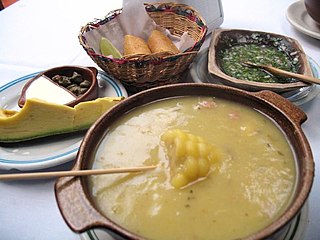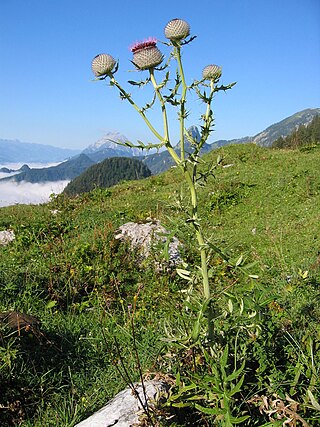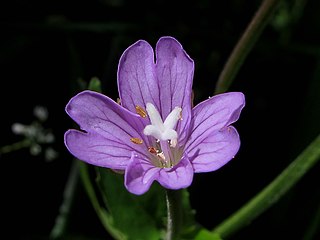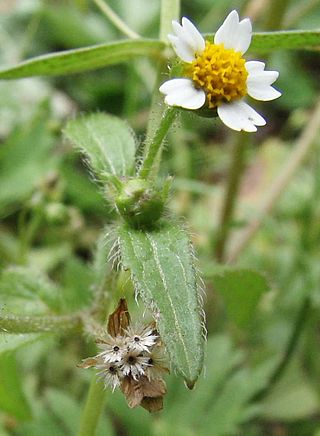
Dahlia is a genus of bushy, tuberous, herbaceous perennial plants native to Mexico and Central America. As a member of the Asteraceae family of dicotyledonous plants, its relatives include the sunflower, daisy, chrysanthemum, and zinnia. There are 49 species of dahlia, with flowers in almost every hue, with hybrids commonly grown as garden plants.

Artemisia vulgaris, the common mugwort, is a species of flowering plant in the daisy family Asteraceae. It is one of several species in the genus Artemisia commonly known as mugwort, although Artemisia vulgaris is the species most often called mugwort. It is also occasionally known as riverside wormwood, felon herb, chrysanthemum weed, wild wormwood, old Uncle Henry, sailor's tobacco, naughty man, old man, or St. John's plant. Mugworts have been used medicinally and as culinary herbs.

Aronia is a genus of deciduous shrubs, the chokeberries, in the family Rosaceae native to eastern North America and most commonly found in wet woods and swamps. The genus Aronia is considered to have 3 species. The most common and widely used is Aronia melanocarpa which emerged from Eastern North America. The lesser known Aronia arbutifolia and the hybrid form of the abovementioned species called Aronia prunifolia were first cultivated in Central and Eastern North America. In the eighteenth century, the first shrubs of the best-known species Aronia melanocarpa reached Europe where they were first cultivated in Scandinavia and Russia.

Antonio José Cavanilles was a leading Spanish taxonomic botanist, artist and one of the most important figures in the 18th century period of Enlightenment in Spain.

Lactuca virosa is a plant in the Lactuca (lettuce) genus, often ingested for its mild analgesic and sedative effects. It is related to common lettuce, and is often called wild lettuce, bitter lettuce, laitue vireuse, opium lettuce, poisonous lettuce, tall lettuce, great lettuce or rakutu-karyumu-so.

Caffeic acid is an organic compound with the formula (HO)2C6H3CH=CHCO2H. It is a yellow solid. Structurally, it is classified as a hydroxycinnamic acid. The molecule consists of both phenolic and acrylic functional groups. It is found in all plants as an intermediate in the biosynthesis of lignin, one of the principal components of biomass and its residues. It is unrelated to caffeine.

Ferulic acid is a hydroxycinnamic acid; it is an organic compound with the formula (CH3O)HOC6H3CH=CHCO2H. The name is derived from the genus Ferula, referring to the giant fennel (Ferula communis). Classified as a phenolic phytochemical, ferulic acid is an amber colored solid. Esters of ferulic acid are found in plant cell walls, covalently bonded to hemicellulose such as arabinoxylans. Salts and esters derived from ferulic acid are called ferulates.

Ajiaco is a soup common to Colombia, Cuba, and Peru. Scholars have debated the origin of the dish. The dish is especially popular in the Colombian capital, Bogotá, being called Ajiaco santafereño, where it is typically made with chicken, three varieties of potatoes, and the herb Galinsoga parviflora, known locally as guasca or guascas. In Cuba, ajiaco is prepared as a stew, while in Peru the dish is prepared with a number of regionally specific variations.

The phenylpropanoids are a diverse family of organic compounds that are biosynthesized by plants from the amino acids phenylalanine and tyrosine in the shikimic acid pathway. Their name is derived from the six-carbon, aromatic phenyl group and the three-carbon propene tail of coumaric acid, which is the central intermediate in phenylpropanoid biosynthesis. From 4-coumaroyl-CoA emanates the biosynthesis of myriad natural products including lignols, flavonoids, isoflavonoids, coumarins, aurones, stilbenes, catechin, and phenylpropanoids. The coumaroyl component is produced from cinnamic acid.

Glebionis coronaria, formerly called Chrysanthemum coronarium, is a species of flowering plant in the family Asteraceae. It is native to the Mediterranean region. It is cultivated and naturalized in East Asia and in scattered locations in North America.

Cirsium eriophorum, the woolly thistle, is a herbaceous biennial species of flowering plant in the genus Cirsium of the family Asteraceae. It is widespread across much of Europe. It is a large biennial plant with sharp spines on the tips of the leaves, and long, woolly hairs on much of the foliage. The flower heads are large and nearly spherical, with spines on the outside and many purple disc florets but no ray florets.

Epilobium montanum or Broad-leaved Willowherb is a species of flowering plant in the willowherb family Onagraceae.

Cicerbita alpina, commonly known as the alpine sow-thistle or alpine blue-sow-thistle is a perennial herbaceous species of plant sometimes placed in the genus Cicerbita of the family Asteraceae, and sometimes placed in the genus Lactuca as Lactuca alpina. It is native to upland and mountainous parts of Europe.

Galinsoga quadriradiata is a species of flowering plant in the family Asteraceae which is known by several common names, including shaggy soldier, Peruvian daisy, hairy galinsoga. Its native home is apparently central Mexico, although it has become naturalized in many other places.

Senecio angulatus, also known as creeping groundsel and Cape ivy, is a succulent flowering plant in the family Asteraceae that is native to South Africa. Cape ivy is a scrambling herb that can become an aggressive weed once established, making it an invasive species. It is grown as an ornamental plant for its satiny foliage and sweet-scented flowers.

Eryngium planum, the blue eryngo or flat sea holly, is a species of flowering plant in the family Apiaceae, native to the area that includes central and southeastern Europe and central Asia. It is an herbaceous perennial thistle growing to 50 cm (20 in) with branched silvery-blue stems, and numerous small blue conical flowerheads surrounded by spiky bracts in summer.

Propolis or bee glue is a resinous mixture that honey bees produce by mixing saliva and beeswax with exudate gathered from tree buds, sap flows, or other botanical sources. It is used as a sealant for unwanted open spaces in the beehive. Propolis is used for small gaps, while gaps larger than the bee space are usually filled with burr comb. Its color varies depending on its botanical source, with dark brown as the most common. Propolis is sticky above 19 °C (66 °F), while at lower temperatures, it becomes hard and brittle.

Crepis biennis is a European species of flowering plant in the family Asteraceae with the common name rough hawksbeard. It is native to Europe and Asia Minor, as well as being sparingly naturalized in scattered locations in the northeastern United States and on the island of Newfoundland in eastern Canada.

Erigeron speciosus is a widespread North American species of flowering plants in the family Asteraceae known by the common names aspen fleabane, garden fleabane, and showy fleabane.

Tagetes micrantha is a North American species of wild marigold within the family Asteraceae, common name licorice marigold. It is widespread across much of Mexico from Chihuahua to Oaxaca, and found also in the southwestern United States.





















